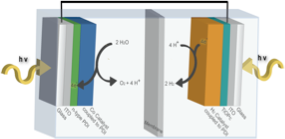Heterogeneous Artificial Photosynthesis Systems for Complete Fuel Forming Reactions:  Harnessing solar energy is necessary for creating a sustainable energy future. We are currently developing artificial photosynthetic systems capable of complete fuel forming reactions, including water splitting. This project is in collaboration with Brian Gregg of the National Renewable Energy Laboratories in Golden, CO.
Harnessing solar energy is necessary for creating a sustainable energy future. We are currently developing artificial photosynthetic systems capable of complete fuel forming reactions, including water splitting. This project is in collaboration with Brian Gregg of the National Renewable Energy Laboratories in Golden, CO.
 Water Oxidation Catalysis: Who’s the Catalyst? The oxidation of water coupled to proton or CO2 reduction is necessary for fuel forming reactions; vide supra. Water oxidation is currently the kinetic bottle neck of this reaction when H2 is generated as the fuel. In water oxidation catalysis (WOC), as with all catalysis, the identity of the true catalyst must be known in order to optimize and rationally synthesize the next generation of catalysts. We have demonstrated, along with others, that many claimed WOC’s are actually catalytic precursors to highly active heterogeneous catalysts. We are currently working with the best known catalysts to answer the question “who’s the catalyst?” en route to long-lived and highly active WOC’s.
Water Oxidation Catalysis: Who’s the Catalyst? The oxidation of water coupled to proton or CO2 reduction is necessary for fuel forming reactions; vide supra. Water oxidation is currently the kinetic bottle neck of this reaction when H2 is generated as the fuel. In water oxidation catalysis (WOC), as with all catalysis, the identity of the true catalyst must be known in order to optimize and rationally synthesize the next generation of catalysts. We have demonstrated, along with others, that many claimed WOC’s are actually catalytic precursors to highly active heterogeneous catalysts. We are currently working with the best known catalysts to answer the question “who’s the catalyst?” en route to long-lived and highly active WOC’s.
 Kinetic and Mechanistic Studies of Nanoparticle Formation and Catalysis: Starting from a well-defined Ir(1,5-COD)P2W15Nb3O62 precursor, we have unraveled what looks to be a much more widely applicable mechanism governing the self-assembly of transition metal nanoparticles. In addition, we now understand their stabilization mechanisms and catalysis. Currently, we are extending our kinetic and mechanistic studies to the formation of supported-nanoparticle heterogeneous catalyst formation in contact with solution—en route to improved heterogeneous catalysts; the most industrially important types of catalysts.
Kinetic and Mechanistic Studies of Nanoparticle Formation and Catalysis: Starting from a well-defined Ir(1,5-COD)P2W15Nb3O62 precursor, we have unraveled what looks to be a much more widely applicable mechanism governing the self-assembly of transition metal nanoparticles. In addition, we now understand their stabilization mechanisms and catalysis. Currently, we are extending our kinetic and mechanistic studies to the formation of supported-nanoparticle heterogeneous catalyst formation in contact with solution—en route to improved heterogeneous catalysts; the most industrially important types of catalysts.
Understanding Nucleation and Growth Across Nature:  Our kinetic and mechanistic studies of nanocluster formation led to the development of a 2-step mechanism of nucleation (A ➝ B, k1) and growth (A + B ➝ 2B, k2). We are currently exploring its relation to a broader range of self assembly systems across nature including: (i) supported-nanoparticle heterogeneous catalyst formation, (ii) proteins in neurological diseases, (iii) solid-state phase transformations﹣including Avrami type transformations, (iv) organometallic catalyst formation and (v) dioxygenase oxidation catalysis. This is a wide-open area that involves everything from kinetic studies, computational work, XAFS and other synchrotron-radiation methods, plus the analysis of diverse areas of scientific literature.
Our kinetic and mechanistic studies of nanocluster formation led to the development of a 2-step mechanism of nucleation (A ➝ B, k1) and growth (A + B ➝ 2B, k2). We are currently exploring its relation to a broader range of self assembly systems across nature including: (i) supported-nanoparticle heterogeneous catalyst formation, (ii) proteins in neurological diseases, (iii) solid-state phase transformations﹣including Avrami type transformations, (iv) organometallic catalyst formation and (v) dioxygenase oxidation catalysis. This is a wide-open area that involves everything from kinetic studies, computational work, XAFS and other synchrotron-radiation methods, plus the analysis of diverse areas of scientific literature.